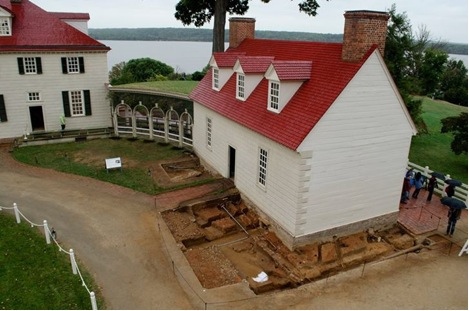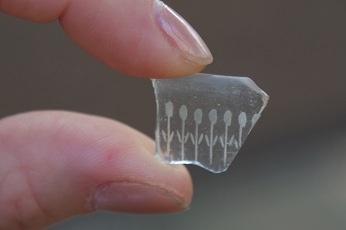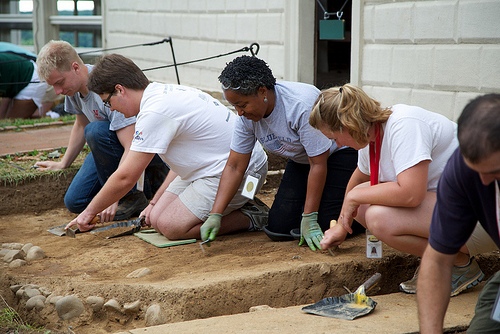
Mount Vernon, Virginia — Anyone visiting George Washington’s Mount Vernon plantation estate today couldn’t possibly miss, among other things, this U.S. Founding Father’s large, white, well-appointed mansion house and its associated outbuildings. It has graced post cards for decades. It represents his home as it looked in its prime, as he lived in it following his terms as the Nation’s first President.
What visitors don’t usually see, however, are the remains of a different estate lying just below the surface — different because, in 1775, Washington embarked on a major campaign to renovate and remodel the Mansion, outbuildings, and even the landscape, transforming it to the place visitors see restored today. Now, archaeologists are exposing part of the hidden pre-1775 footprint, more particularly the foundations of an early pre-Revolutionary War kitchen adjacent to the west side of the Mansion.
“We uncovered sections of the north, east, and south brick wall foundations of the first-period kitchen and the north cheek of its chimney base,” writes Luke Pecoraro, Assistant Director for Archaeological Research at Mount Vernon in a report. Other artifacts included fragments of white salt-glazed stoneware, a type of ceramic ware imported directly from England and used at Mount Vernon in the late 1750’s, and hand-painted pearlware, a type of ceramic ware that is not documented in the orders of imports to the estate, and thus could only have been revealed through archaeological investigation.
_________________________________________________________________________________________
Overall site photo of the kitchen excavation area. The post-1775 kitchen, the kitchen most visitors see today, is the white building adjacent to the excavation area. Courtesy Mount Vernon Preservation
_________________________________________________________________________________________
Archaeologists know, based on the estate inventory taken after Washington’s older half-brother Lawrence’s death in 1752, that there were four pre-1775 outbuildings, which included an earlier storehouse, dairy, kitchen, and washhouse. In conjunction with the archaeological record, this has defined an approximate visual concept of the earlier Mount Vernon Mansion complex. To further investigate and elucidate this earlier construction, Mount Vernon’s Historic Preservation and Collections Department, in conjunction with the Historic Preservation Program in the Department of Architecture, Planning and Preservation at the University of Maryland (UMD), organized a field school led by archaeologists and consisting of students representing 8 U.S. universities. Says Pecoraro: “The focus of the summer [2013] field work was the 1775 kitchen, offering an opportunity for us to explore the first generation of outbuildings at Mount Vernon, specifically an early kitchen and dairy, that George Washington inherited from his brother Lawrence and used for approximately 20 years before tearing them down to enlarge the Mansion, build a new kitchen, and connect the two with a covered archway.”
“A single test unit was opened for the dairy, where we encountered the intact southwest corner of the building’s sandstone foundations,” added Pecoraro. “Artifacts found in the eighteenth-century dairy destruction rubble included fragments of ceramic vessels, plaster from the interior walls, and a decorated rim to a wine glass bearing a pattern that was identical to a sherd recovered from the near-by South Grove midden.”
The South Grove midden was a refuse pit used by the Washington family and enslaved families during the late 18th century. Located near the family kitchen, it was excavated by archaeologists from 1990 through 1994, resulting in the recovery of nearly 300,000 artifacts.
__________________________________________________________________________________________
Wine glass fragment found during the dairy excavation; the same pattern was found in an earlier excavation roughly 50 feet south in the South Grove midden. Courtesy Mount Vernon Preservation
__________________________________________________________________________________________
“Our final discovery [for the 2013 season] was the cobblestone surface of what we believe to be George Washington’s circular driveway,” Pecoraro continued. “In some places it is less than an inch below the modern road surface. These cobblestones had been documented in two previous excavations.”
The field school will continue at least through the next season in 2014. Individuals interested in participating should link to the informational flyer here.
See the project website for more, including videos.
___________________________________________________________________________________________
Students and staff archaeologists excavating in front of the kitchen. Courtesy Mount Vernon Preservation
_________________________________________________________________________________________
Read about the most fascinating discoveries with a premium subscription to Popular Archaeology Magazine. Find out what Popular Archaeology Magazine is all about, including the special Holiday Discount offer. AND MORE:
 Popular Archaeology’s annual Discovery edition is a selection of the best stories published in Popular Archaeology Magazine in past issues, with an emphasis on some of the most significant, groundbreaking, or fascinating discoveries in the fields of archaeology and paleoanthropology and related fields. At least some of the articles have been updated or revised specifically for the Discovery edition. We can confidently say that there is no other single issue of an archaeology-related magazine, paper print or online, that contains as much major feature article content as this one. The latest issue, volume 2, has just been released. Go to the Discovery edition page for more information.
Popular Archaeology’s annual Discovery edition is a selection of the best stories published in Popular Archaeology Magazine in past issues, with an emphasis on some of the most significant, groundbreaking, or fascinating discoveries in the fields of archaeology and paleoanthropology and related fields. At least some of the articles have been updated or revised specifically for the Discovery edition. We can confidently say that there is no other single issue of an archaeology-related magazine, paper print or online, that contains as much major feature article content as this one. The latest issue, volume 2, has just been released. Go to the Discovery edition page for more information.
Subscription Price: A very affordable $5.75 for those who are not already premium subscribers of Popular Archaeology Magazine (It is FREE for premium subscribers to Popular Archaeology). Premium subscribers should email [email protected] and request the special coupon code. Or, for the e-Book version, it can be purchased for only $3.99 at Amazon.com.







